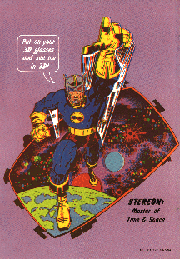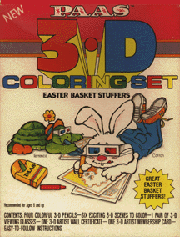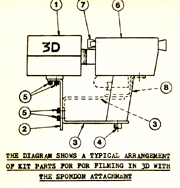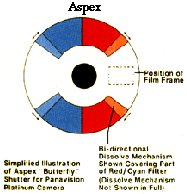
In 1982 the 3D Video Corporation, in conjunction with its 3-D broadcast TV activities, published a 3-D comic book titled Battle for a Three Dimensional World. The backcover of this comic book featured the first polychromatic anaglyph cartoon image. Using limited parallax, a finely tuned color palette and a precise placement of the stereo window, this image depicted a superhero named Stereon flying through a cosmic window with fist extended. The color 3-D conversion of this image was the work of Tony Alderson, an in-house stereographer at 3D Video Corporation.

Early in 1984 a toy and game inventor named Howard Wexler filed a patent for Multi-Colored Anaglyphs which he claimed improves the anaglyphic print and print process through the addition of one or more colors to one of the two colored pictures. Further, the added colors are not limited to the colors used to render the pictures, but can be any of a great variety of colors. By this time Wexler had employed the services of Joe Kubert to create a 3-D Coloring Set for the Paas company of Easter Basket Stuffers in which children colored an enclosed set of two-color anaglyph cartoons with crayolas that were supplied in the set.

In 1985 Wexler retained the services of The 3-D Zone to produce the color 3-D separations for a series of Colorforms 3-D Playsets featuring the popular TV characters Thundercats, Golden Girl and the Muppet Babies. Subsequently, The 3-D Zone produced the 3-D separations for a series of 3-D Coloring Books after the Wexler concept.
Polychromatic line anaglyphs were issued sporadically over the next several years with work through The 3-D Zone. Comic book titles included the normalman 3-D annual from Renegade Press with a color 3-D centerspread, The Worlds 1st color 3-D Hollywood Paperdolls published by The 3-D Zone and in 1992 The Simpsons 3-D Annual. Several issues of 3-D Zone comics featured multicolor line anaglyph backcovers with Krazy Kat and four issues of Tex Benson by Chuck Roblin. Polychromatic anaglyph photocovers were featured with 3-D Presidents and Hollywood 3-D.
By the late 1980s there had been several color anaglyph TV broadcasts in the Los Angeles area. The 1950s 3-D films Inferno and Hondo , starring John Wayne, were encoded for polychromatic anaglyph broadcast as well as original footage for a local Los Angeles news program.
Interestingly, several technological developments were promoted for color anaglyph movies, video and photography that were reinventions of devices from previous years. The first was a 3D Movie Kit from Spondon Film Services in Derby, Great Britain that was sold to the consumer market. The Spondon 3-D attachment contained glass and mirrors in the same configuration as the Leslie Dudley optical attachment which superimposed stereoscopic pairs to form direct anaglyphs in natural color. Two optical paths were directed through red and green filters into a single prime lens. The Spondon device was a cost effective unit for use in the consumer market with 8mm and 16mm films as well as video. A prototype using a front surface mirror, dichroic filters and an adjustable convergence was also built a few years prior to the Spondon 3-D movie kit by John Rupkalvis of the Stereoscope Company in Burbank, California. Only a limited number of Spondon 3D Movie Kits were ever produced.

In 1988 a British company calling itself Aspex Limited introduced their Aspex device for motion pictures and it was virtually identical to the old Kinemacolor process except that it was created for use with a Panavision movie camera and color film stock. Aspex used a butterly shutter with red/cyan filters to record successive complementary-colored images. Object or camera movement in a horizontal direction produced the parallax motion necessary for separate left and right eye points of view recorded on full-color film stock. A demo rock video with Gladys Knight and the Pips was produced in Aspex but the process never went any further.

In the early 1990s the ingenious David Burder of Great Britain produced for Vivitar his Q-DOS lens which like the VideoWEST process of 1974 used color filters and a stereo base within the prime lens itself to produce a compatible color anaglyph photo. 3-D inventor Stephen Hines of HinesLab in Glendale has also produced images of this kind and an instant 3-D photobooth for portraiture using this technique.
